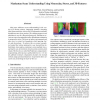Free Online Productivity Tools
i2Speak
i2Symbol
i2OCR
iTex2Img
iWeb2Print
iWeb2Shot
i2Type
iPdf2Split
iPdf2Merge
i2Bopomofo
i2Arabic
i2Style
i2Image
i2PDF
iLatex2Rtf
Sci2ools
ICCV
2011
IEEE
2011
IEEE
Manhattan Scene Understanding Using Monocular, Stereo, and 3D Features
This paper addresses scene understanding in the context of a moving camera, integrating semantic reasoning ideas from monocular vision with 3D information available through structure–from–motion. We combine geometric and photometric cues in a Bayesian framework, building on recent successes leveraging the indoor Manhattan assumption in monocular vision. We focus on indoor environments and show how to extract key boundaries while ignoring clutter and decorations. To achieve this we present a graphical model that relates photometric cues learned from labeled data, stereo photo–consistency across multiple views, and depth cues derived from structure–from–motion point clouds. We show how to solve MAP inference using dynamic programming, allowing exact, global inference in ∼100 ms (in addition to feature computation of under one second) without using specialized hardware. Experiments show our system out–performing the state–of–the–art.
| Added | 12 Dec 2011 |
| Updated | 12 Dec 2011 |
| Type | Journal |
| Year | 2011 |
| Where | ICCV |
| Authors | Alex Flint, David Murray, Ian Reid |
Comments (0)

